The McPhotoVideo Photo Blog page contains back stories and interesting technical details behind many of the images and videos featured in my portfolios. It also contains my opinions on new equipment, ideas for taking better pictures, and photo trends.
By Michael J. McNamara
Have you ever noticed how time flies when you’re taking imaginary racing photos? If so, welcome to the club. I “took” my first fake racing photo back in 2005 while researching a story for a Digital Directions column in Popular Photography Magazine. After Sony released Gran Turismo 4 racing simulator game for the Playstation 2 with its unique Photo modes, I took a deep drive into the game’s potential as a photography-teaching tool. See story below.
Funny thing is the images I made back then are still fooling people today. To see for yourself, check out this VIRTUAL GALLERY and see if you can find the real photos in there.
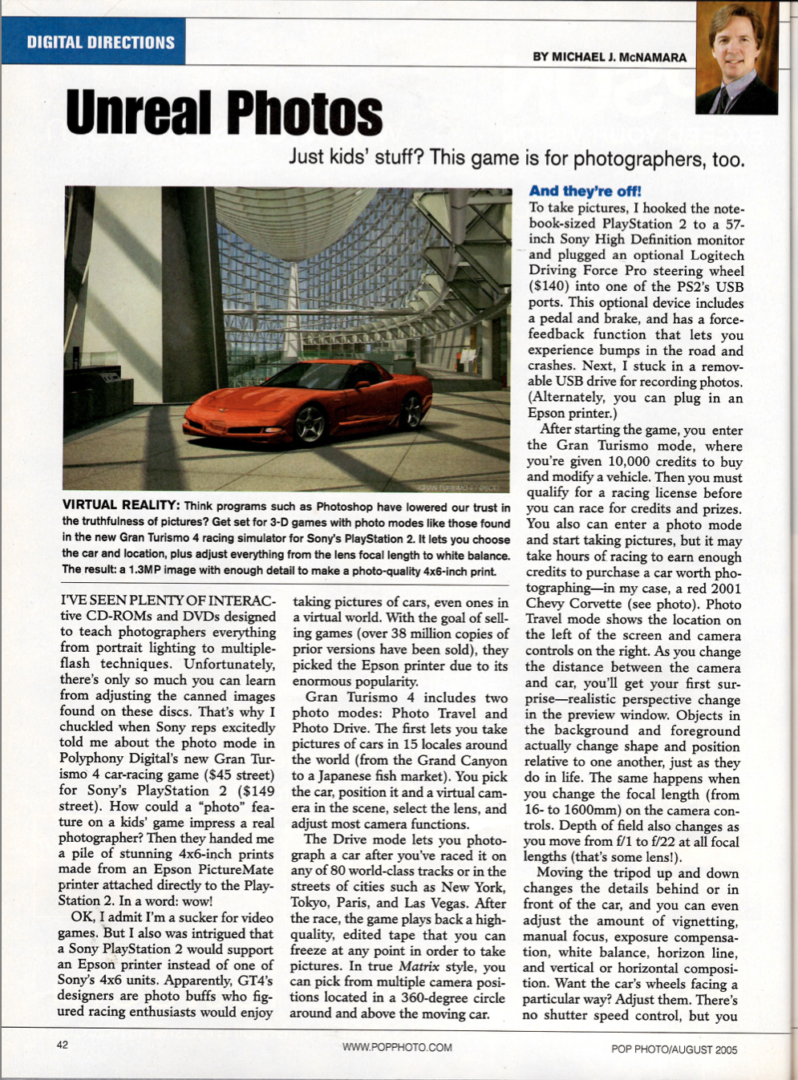
.

VIRTUAL PHOTO GALLERY FULL SCREEN
CLICK ON ANY IMAGE BELOW TO VIEW LARGER, AND AGAIN TO SEE NEXT PHOTO
By Michael J. McNamara
Have you ever taken a selfie with wild butterflies flying around you? Or gotten so close to a butterfly that you could hear its wings flap as it flew to another flower? For Summer visitors to the flower gardens at Fishkill Farms In Hopewell Junction, NY, the answer is often “Yes! Want to see my phone shots?”
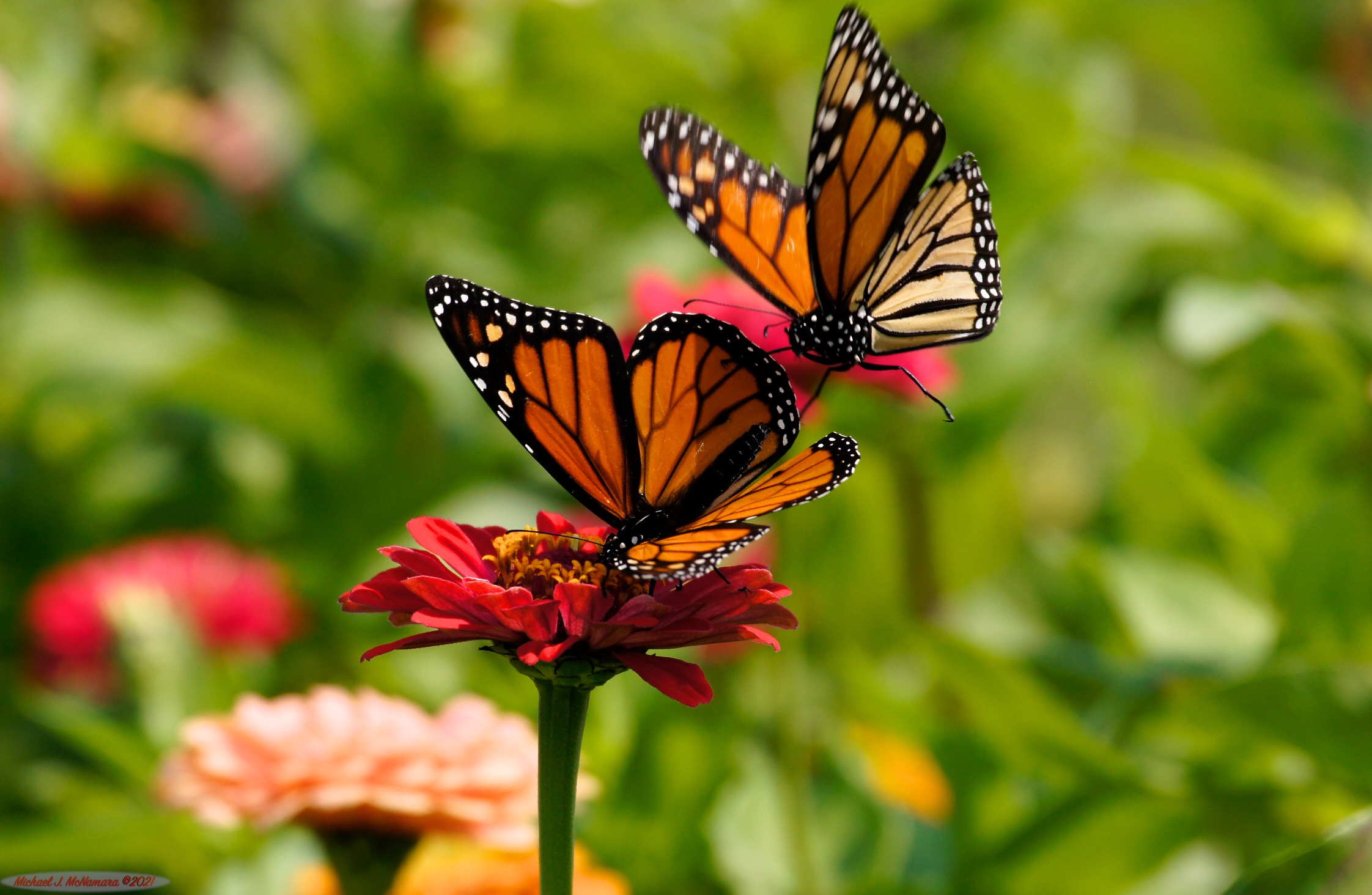
That’s because the farm’s organic gardens are like a well-stocked grocery store for butterflies and other pollinators, offering thousands of flowers to feast on and a safe place to breed. The abundant food supply has two unusual effects on otherwise skittish butterflies. First, they slow down while eating, and second, they let humans get much closer than normal–often within inches, not yards.
In the years that I’ve been taking pictures of these colorful creatures I haven’t found any outside gardens in lower NY (including those that charge entrance fees) that contain nearly as many migrating Monarchs and native butterflies. As an example, during a short walk on July 30th I counted over a dozen migrating Monarchs, a Queen Butterfly, several Great Spangled Fritillary, and nearly two dozen Yellow, Black, and Spicebush Swallowtails. (Read on for info on how to identify these butterflies.) I didn’t even count the smaller butterfly species present in far greater numbers, including Sulphurs, Red Admirals, and Viceroys. All-in-all, not a bad way to spend my lunch hour.
My experience at the farm is not unique. I constantly hear farm visitors expressing their amazement at the number of butterflies they’re seeing and how close they (and their kids) are able to get. For butterfly lovers, multiple visits to the farm’s flower gardens should be on your to-do list between now and mid-October. There’s no fee to enter the gardens or farm during the week, but after Labor Day the Fall Festival Weekends get quite crowded (and may require a reservation).
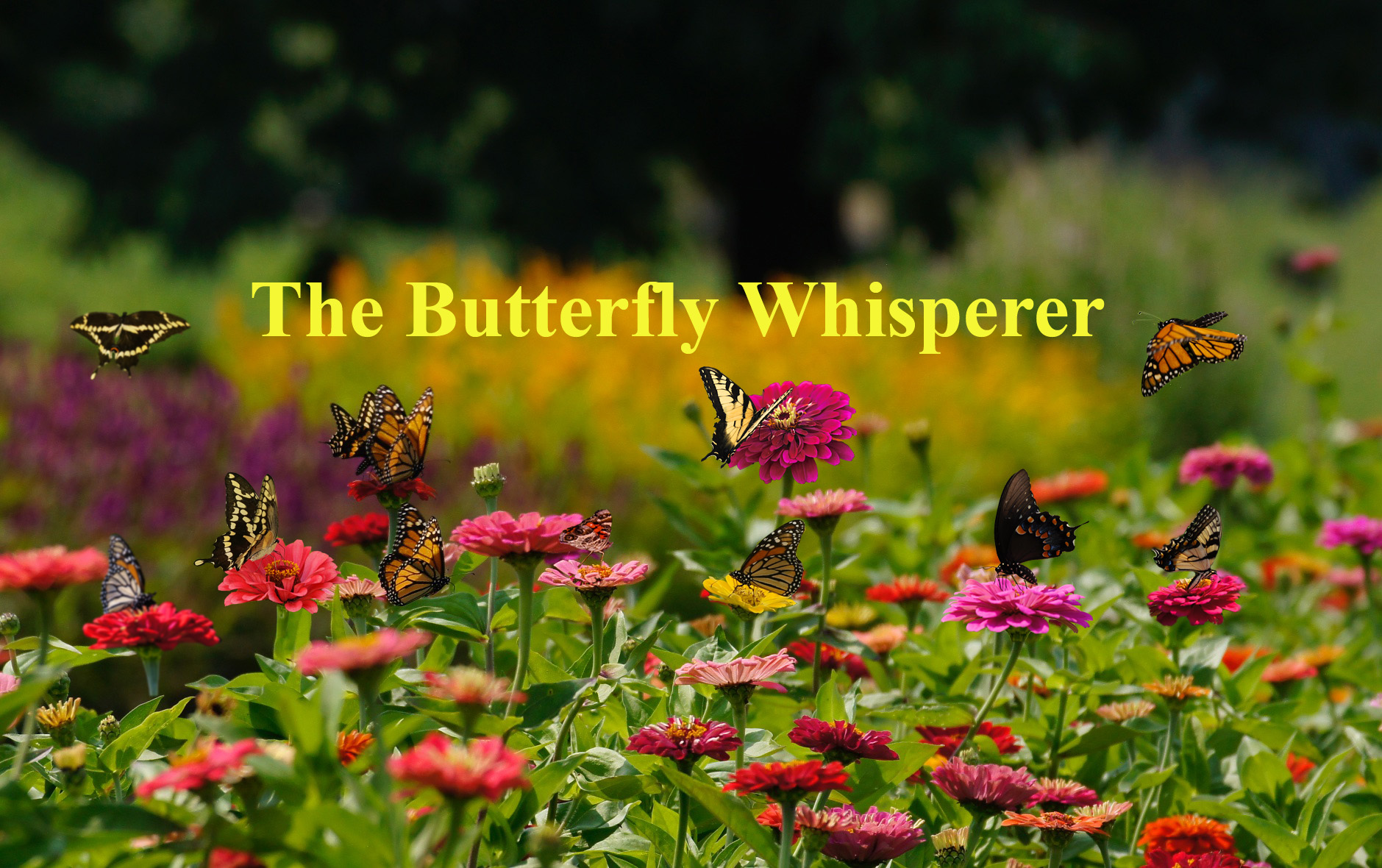
Did you know there are over 57 butterfly species native to NY, and the caterpillars from each species require specific host plants to lay their eggs on? In order to help you identify the larger butterflies that you’ll likely see at the farm or in your own garden, as well as the favorite host plants for each species, I’ve put together the following photos and helpful hints. If you want to attract any or all of these butterflies, consider adding some of the host plants and herbs listed to your gardens along with a variety of high-nectar flowers such as Zinnias. Note: Avoid using pesticides on host plants as they are just as likely to kill caterpillars and honey bees as the are to kill beetles and other garden pests.
The Monarch Butterfly is only migrating butterfly found in the North America, and one of the few migrating insects found worldwide. As a mature butterfly it will drink nectar from just about any flowering plant, although I’ve noticed it really loves Zinnias, Coneflowers, and Orange Butterfly Weed. Only male Monarchs have two distinct black dots on the upper side of their hindwing (one on each side), while females also tend to be a bit smaller than males. A fascinating fact: While mating, the male Monarch stays attached to the female and flies her around from flower to flower for nearly 14 hours on average, losing up to 15% of his body weight in the process.
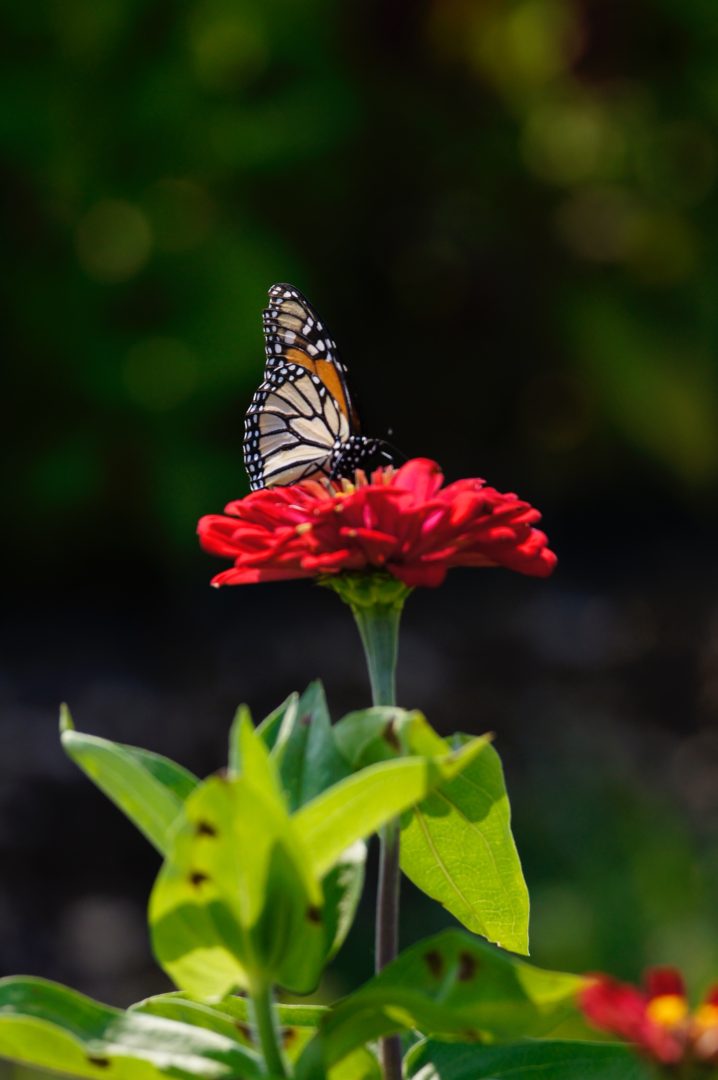
HOST PLANT: When it comes to laying eggs, the female will only choose milkweed plants. Most of these are poisonous to other caterpillars, insects, and animals. When Monarch caterpillars eat milkweed, enough toxins remain in adult butterfly after it emerges from the chrysalis to provide a degree of protection against most birds and natural predators. However, invasive predators including Stinkbug larvae, parasitic wasps, and Tacinid flies are becoming a serious threat to Monarch caterpillars, along with OE spores.
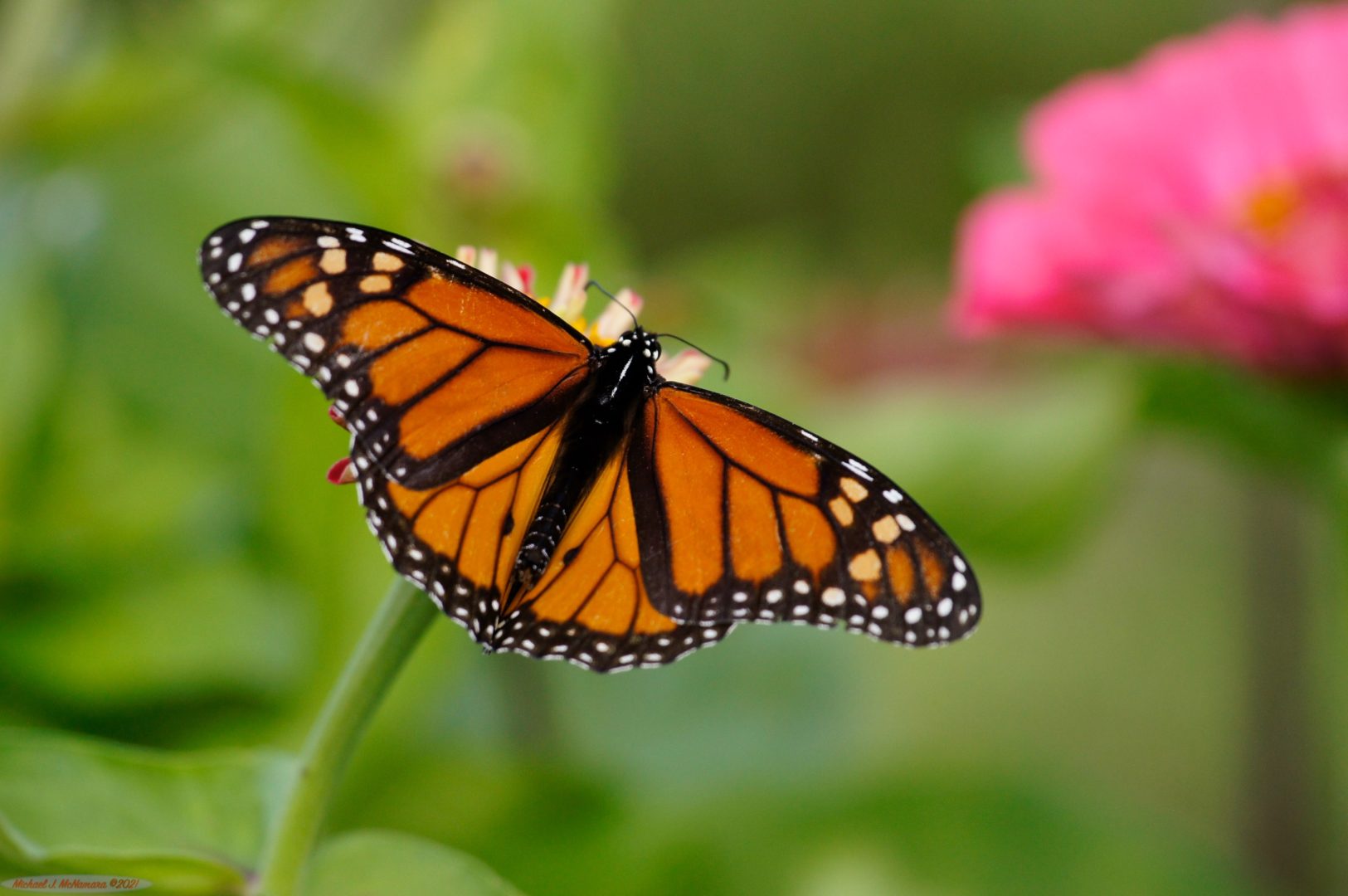
Nationwide, there are nearly 30 varieties of milkweed plants. In the North East and Hudson Valley the most common are Swamp Milkweed, Purple Milkweed, Common Milkweed, and the one I call Monarch Baby Food–Orange Butterfly Weed (also called Pleurisy Root because of its medicinal value).
The Yellow Swallowtail is probably the easiest to identify from a distance due to its large size (up to 5.5 inch wingspan), bright yellow colors and wing patterns. The male is yellow with a black border on its upper wings, and nicknamed the Tiger Swallowtail due to its four black forewing stripes. The female is harder to identify, and may be primarily yellow or black. On the yellow female version there are several blue spots along the hindwing, while the black female version has no yellow patterns on the upper wing, but contains several shades of gray on the upper and lower wings.
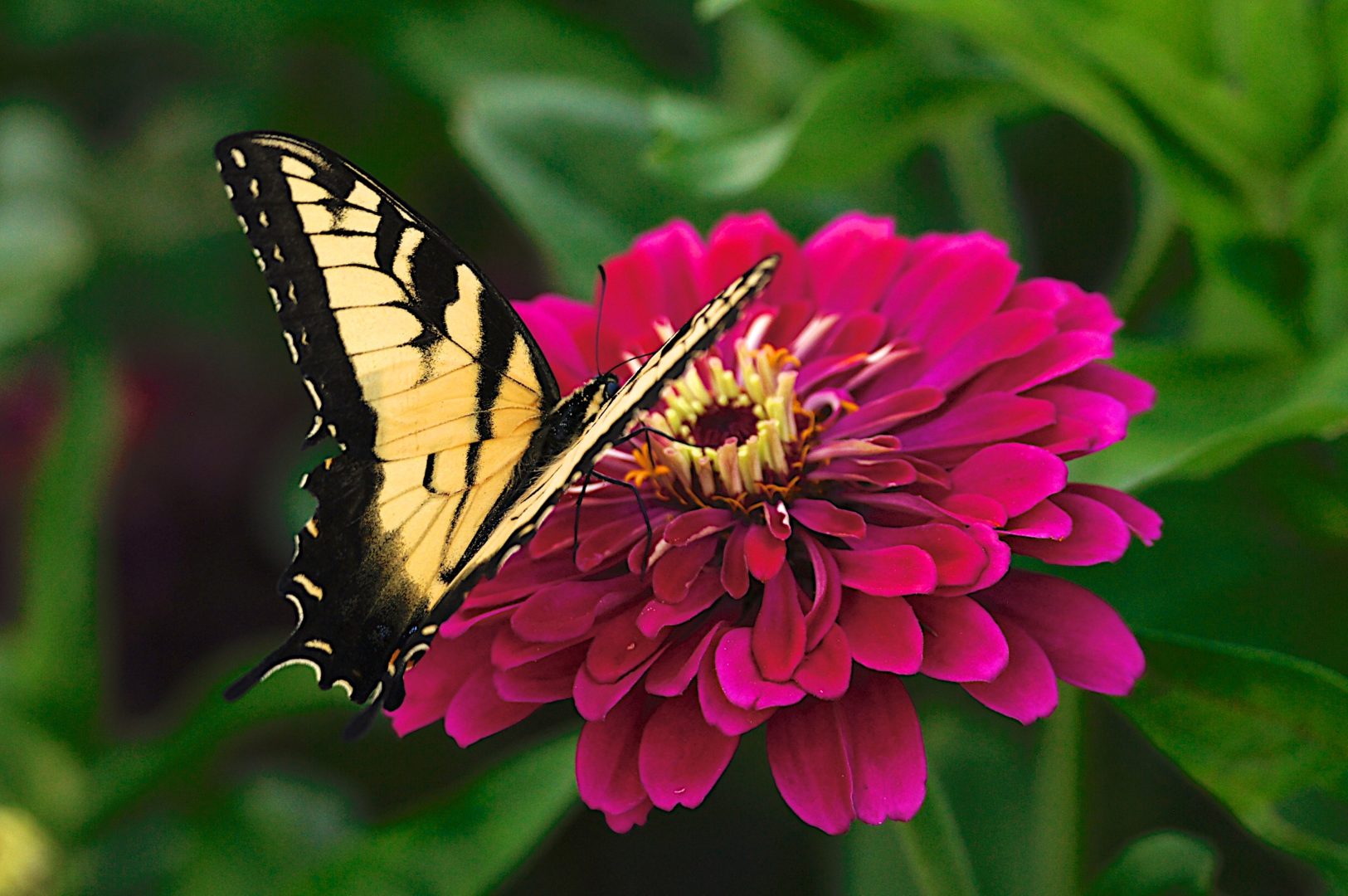
HOST PLANT: The female lays its eggs on all species of magnolia and rose bushes, and several broods can be born throughout the summer months.
About the same size as the Eastern Yellow Swallowtail, the male Black Swallowtail has distinct yellow spots on its upper hindwing, and orange spots mixed with a few blue spots on its underside. The female Black Swallowtail has no yellow on its upper wing but a swath of blue on its lower wing (under a row of white spots). The female lays its eggs exclusively on parsley, so if you notice caterpillars all over your parsley herbs they are most likely from the Black Swallowtail.
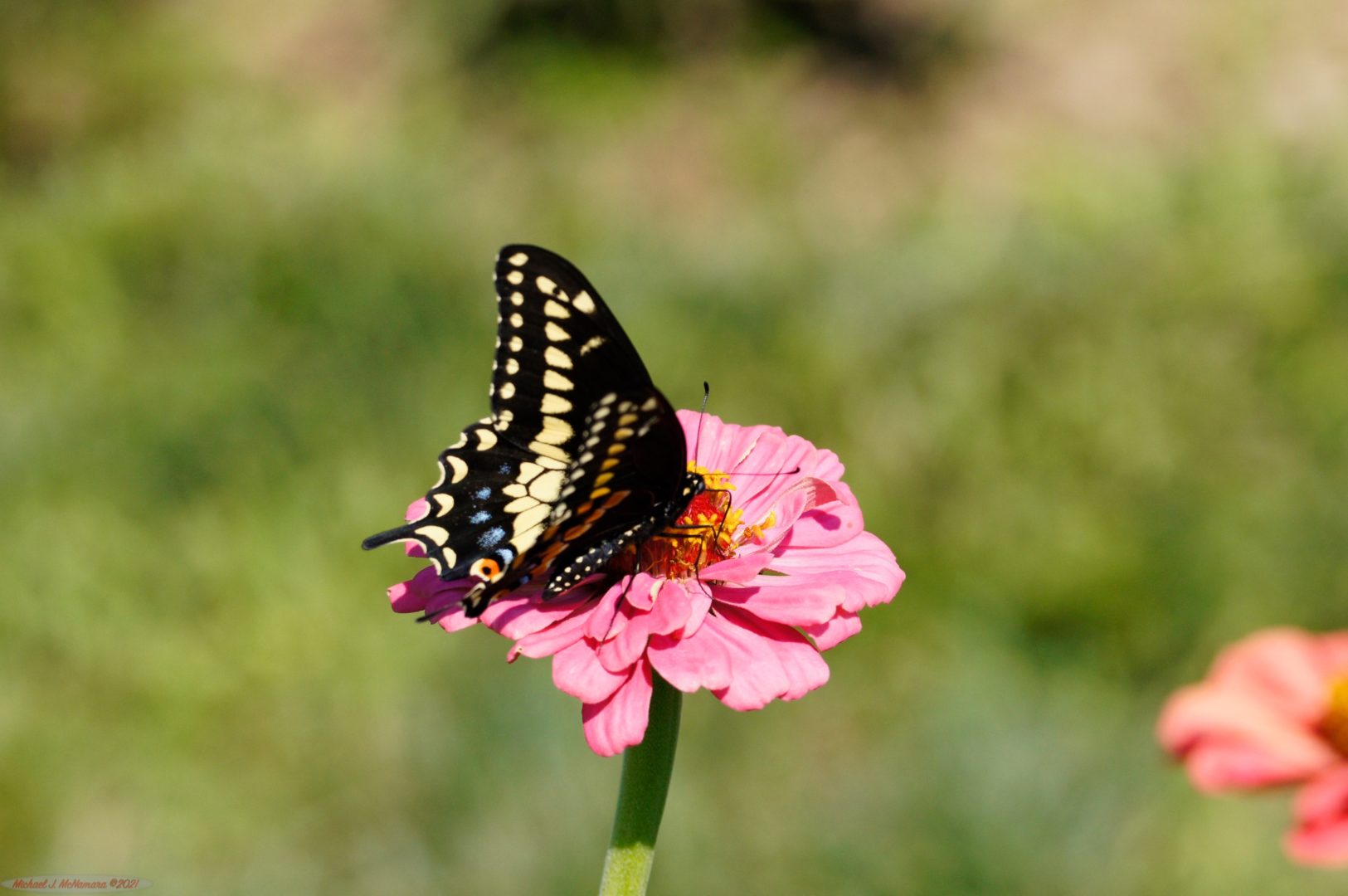
HOST PLANT: The female lays its eggs on all species of magnolia and rose bushes, and several broods can be born throughout the summer months.
The rarest of the large butterflies in the region (I’ve only seen a handful in the last five years), the Queen looks like a male Black Swallowtail from above and at a distance, but as its wings open you’ll notice a nearly solid line of yellow spanning from wing tip to wing tip, and a yellow border around its lower hindwing. It’s also similar in size (up to 3.3-inch wingspan) to the other swallowtails just mentioned, and has a distinct yellow coloration onthe bottom of its wings, unlike the Black Swallowtail. It’s also the only butterfly in this region, other than the Monarch, whose caterpillars thrive on milkweed, and therefore the adult is toxic to most predators.
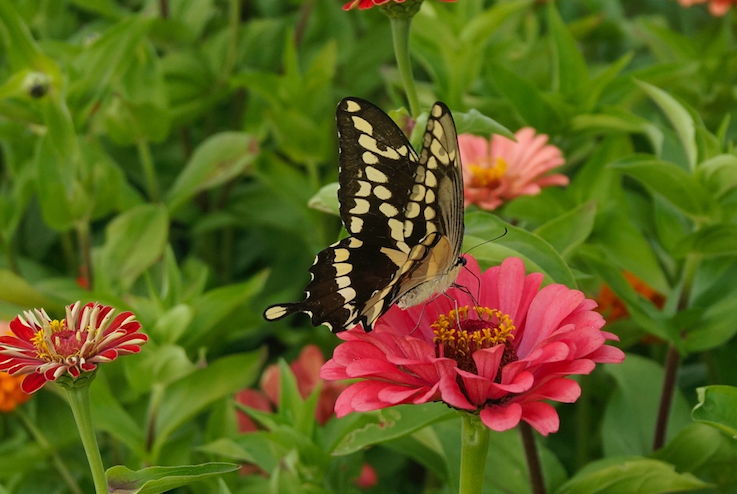
Similar in appearance to the black version of the female Yellow Swallowtail, but typically smaller in size than either the Yellow or Black Swallowtail, the Spicebush Swallowtail can be readily identified when it shows off the metallic green-blue (male) or light blue (female) coloration on its upper hindwings. In both cases, that blueish area is larger and doesn’t have a row of white dots above it as found on the Black Swallowtail. The Spicebush Swallowtail usually flies closer to the ground as well. Females lay their eggs on Spicebush plants, and that explains the name of this critter.
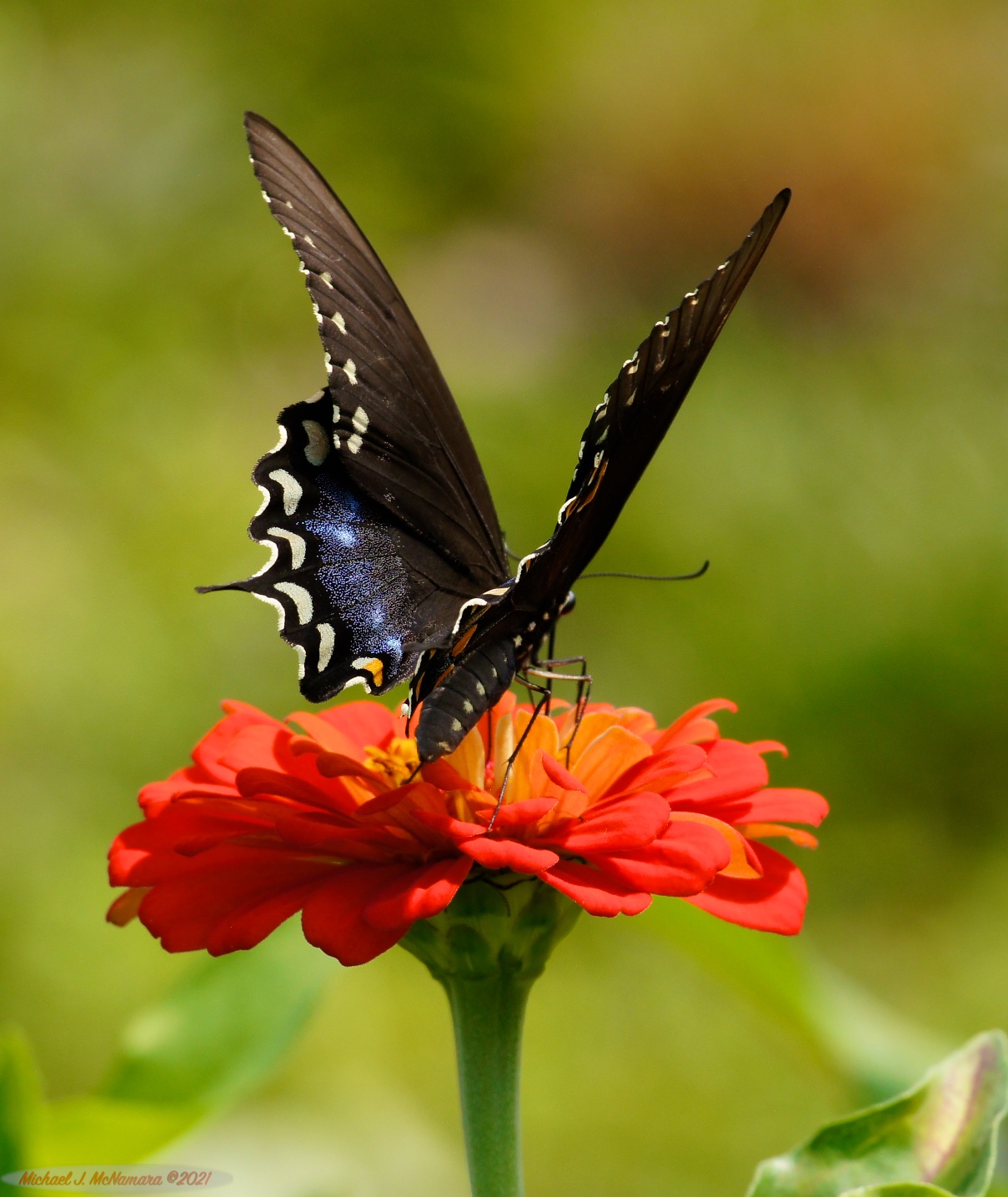
HOST PLANT: The female lays its eggs on all species of magnolia and rose bushes, and several broods can be born throughout the summer months.
Usually among the first butterflies to show up in mid to late June, the Great Spangled Fritillary can easily be confused with the Silver, Aphrodite, and Atlantis Fritillary in regions where they co-exist. However, in lower NY if you spot a Fritillary it’s often this specific version. In my experience, they love to eat from Orange Butterfly Weed, which is often among the first plants to flower (I’ve seen nearly two dozen on one plant).
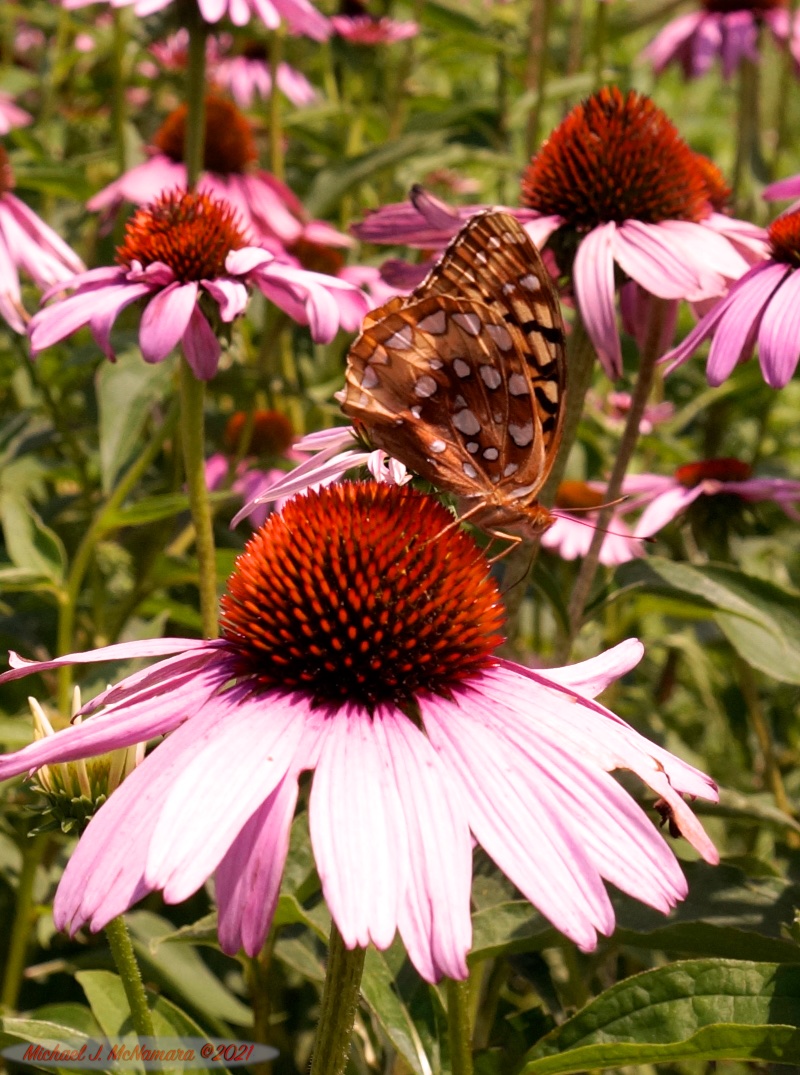
HOST PLANT: The female lays its eggs on native violets and blue violets, both of which appear to be vanishing from many gardens in the area due to replacement by a wide variety of commercial violets. As a result, it’s getting harder to spot Fritillary in places where they were once among the most plentiful.
By Michael J. McNamara (originally published on Fishkill Farms website, July 2, 2021.)
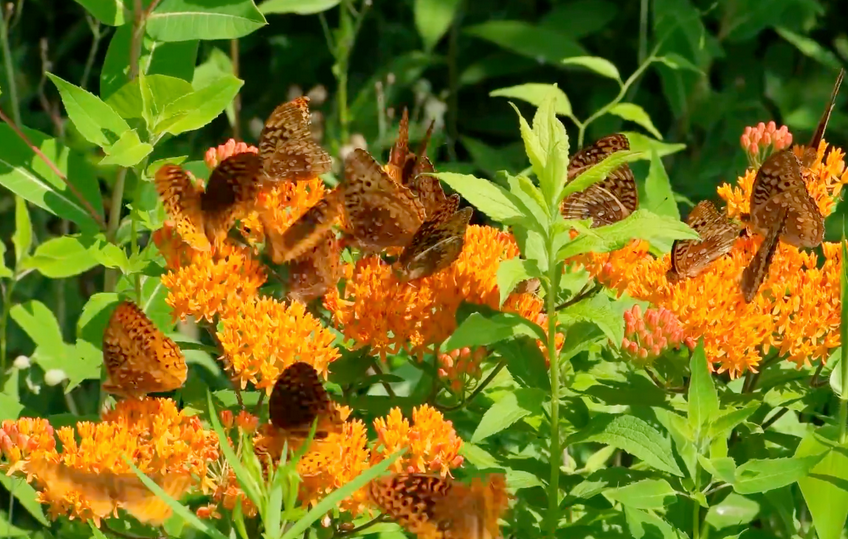
This holiday weekend Fishkill Farm visitors will be treated to a rare sight—over 100 native Orange Butterfly Weed plants (Asclepias Tuberosa) in full bloom. These eye-catching milkweed plants are a favorite food source for all bees, butterflies, and hummingbirds, and most importantly, are preferred hosts for egg-laying Monarch Butterflies.
To read the debut Butterfly Whisperer Blog, Visit the News page at Fishkill Farms in Hopewell Junction, NY.
By Michael J. McNamara, March 1989

This is my first published article predicting the future of digital photography and imaging. It was originally written as a term paper for Prof. Doug Rea’s new Electronic Photography course at RIT in early 1989, and months later published in the Electronic Photography Newsletter (by John Larish, the Editor, who had been a guest speaker in Doug’s class). The article accurately predicts the development of the PhotoCD (three years before Kodak introduced it), doctors using a “photophone” to diagnose illness (which became a reality more than a 2 decade later), online shopping, credit card chips containing photos of owner, and several other “futuristic” advancements that became reality. (see yellow dots).

This Hall & Oates 1982-1983 Gallery contains the top 50 images that I took at six sold-out concerts between June, 1982 and March, 1983. The concerts were the first I ever photographed, so beginners luck may have played a part in getting these amazing photos.
 However, in reality I have to thank my friend Mike Klavana for the Full Access Photo Passes that allowed me to take pictures and move with relative freedom around the stages. Mike started out as a roady for H&O, but his own impressive musical talents eventually landed him a part in the band and credits on several H&O albums, and he has since had an impressive career working with a wide variety of bands. Last time I saw him on stage, he was playing synth and keyboards for Billy Joel (top that!) during Billy’s record-breaking tour at Madison Square Garden. Through Mike, I was able to show H&O band members the shots I had taken at several concerts, and that led to multiple print sales to drummer Mickey Curry and the late, great Base-guitar player T-Bone Wolk. (T-Bone used to carry a shot I took of him in his guitar case–and I know that because he showed it to my brother before a concert in Houston, TX.)
However, in reality I have to thank my friend Mike Klavana for the Full Access Photo Passes that allowed me to take pictures and move with relative freedom around the stages. Mike started out as a roady for H&O, but his own impressive musical talents eventually landed him a part in the band and credits on several H&O albums, and he has since had an impressive career working with a wide variety of bands. Last time I saw him on stage, he was playing synth and keyboards for Billy Joel (top that!) during Billy’s record-breaking tour at Madison Square Garden. Through Mike, I was able to show H&O band members the shots I had taken at several concerts, and that led to multiple print sales to drummer Mickey Curry and the late, great Base-guitar player T-Bone Wolk. (T-Bone used to carry a shot I took of him in his guitar case–and I know that because he showed it to my brother before a concert in Houston, TX.)
 While I sold a few shots to band members, several attempts to show and sell these photos to magazines like Rolling Stone met with closed-doors. Years later, as a magazine editor, I discovered why. First, I was a rookie with no publishing credits, and second–I wasn’t using slide film. In fact, I often got chided by other concert photogs when I told them I was shooting with 400 ISO color and B&W negative films. Unfortunately, in those days and right through the mid-90’s most publications only accepted color slides for submission (how did I know?) even though color negative film had superior contrast, shadow detail, and much lower grain at higher ISO’s. As a result, none of these photos were ever seen by the public until now, with some notable exceptions: in Oct. 1994 a shot I took of H&O’s sax player Charlie DeChant (Mr. Casual) at the New Haven Coliseum appeared on the cover of Popular Photography Magazine. It was one of two illustrations I used for the story “How To Take Concert Photos” that I also wrote as an Associate Editor at Pop Photo (and the 5th of the nearly 3 dozen cover photos I published during my 17-year stint at that magazine.)
While I sold a few shots to band members, several attempts to show and sell these photos to magazines like Rolling Stone met with closed-doors. Years later, as a magazine editor, I discovered why. First, I was a rookie with no publishing credits, and second–I wasn’t using slide film. In fact, I often got chided by other concert photogs when I told them I was shooting with 400 ISO color and B&W negative films. Unfortunately, in those days and right through the mid-90’s most publications only accepted color slides for submission (how did I know?) even though color negative film had superior contrast, shadow detail, and much lower grain at higher ISO’s. As a result, none of these photos were ever seen by the public until now, with some notable exceptions: in Oct. 1994 a shot I took of H&O’s sax player Charlie DeChant (Mr. Casual) at the New Haven Coliseum appeared on the cover of Popular Photography Magazine. It was one of two illustrations I used for the story “How To Take Concert Photos” that I also wrote as an Associate Editor at Pop Photo (and the 5th of the nearly 3 dozen cover photos I published during my 17-year stint at that magazine.)
Click on the article below to read.
After that story ran, I tucked most of my H&O negatives in a closet at work under dozens of film-storage boxes that I filled up over the years, and actually forgot where they were. Can’t tell you how happy I was to re-discover several books of H&O negatives and boxes of prints after I left the magazine in 2008, and also can’t tell you how happy I was when Hall & Oates got nominated to the Rock and Roll Hall Of Fame in 2014!
For me, the band members (and roadies!) of H&O were the most entertaining and talented group of musicians I’ve ever photographed or had the privilege to watch in concert. I only wish my kids (all big H&O fans) could have seen them back then, or that my old Canon A-E1 film camera could have captured HD videos and stereo sound like my phone does now!
Concert photos in the gallery shown below are from New Haven, CT as well as Queens, Rochester, and Buffalo, NY. All the photos were captured on 35mm color negative (Kodak Gold ISO 100-200) or 35mm b&w negative films (Kodak Tri X and Ilford XP1, ISO 200-400) using my first SLR, a Canon AE-1. I had two lenses at the time, a Canon 50mm f/1.8, and a Vivitar Series 1 70-210mm f/4-5.6. The web-optimized images here were downsized from high res scans made by a Plustek 7600i Film Scanner and saved as 3600 ppi resolution, 32-bit TIFF. Stay tuned regarding the availability of archival-prints from select images in this set.
In May, 2009 legendary musician and environmental activist Pete Seeger celebrated his 90th birthday in Madison Square Garden. Helping him celebrate were thousands of fans and dozens of other music legends, including Bruce Springsteen, Arlo Guthrie, Richie Havens, John Mellencamp, Joan Baez, Dave Matthews, Roger McGuin, Taj Mahal, Tom Chapin, and even Oscar the Grouch!
As the Clearwater’s official photographer at this event, I was able to move freely around MSG, taking rare candid photos in green rooms, tech booths, private suites, and dining areas. In the process, I met and photographed most of the musicians, and was able to capture some great shots onstage and backstage–such as the first shot below showing Taj Mahal and Richie Havens (the opening performer at Woodstock) sharing an hysterical moment together.
The gallery below contains all of my favorites–including a few selfies with previously mentioned celebs. All were shot using a 21MP Canon EOS 1Ds Full Frame DSLR, and image quality is superb for making large format prints or extreme cropping. Contact me at mikemcnamara79@mac.com if you’re interested in buying prints or using these images in documentaries.
If you haven’t seen it yet, check out the PBS special on this concert, and keep an eye out for me circling around the stage during the live sequences!
One of the most exciting and challenging photo projects I’ve ever tackled took place in Sept. 2009 while shooting a documentary for UNESCO’s World Heritage Photo Project. It was an incredible experience that I’ll never forget, and one that I hope you can share via the images, stories, and HD videos I brought back with me.
This portfolio contains a small sampling of the thousands of photos I shot during more than two dozen dives on largest and most pristine coral reefs in the world. The photo below of the giant clam is one of my favorites for two reasons:
First, I love the color patterns inside this 3-ft long clam, and second, the photo contains two perfectly camouflaged fish. Look closely to the right of the clam and you may see them! (I didn’t till one of them swam away!)
This project marked the first time I had access to an underwater camera setup that allowed me to shoot 1080p Full HD videos as well as 14mp still photos (a Panasonic GH1 in a custom housing). Several of the movies I shot, including a shark closeup and a mystical visit with an ancient sea turtle, can be found in my Nature Video portfolio.
For more info on this project, check out the Panasonic press release, OurPlace World Heritage.com, or the article at McNamaraReport.com.
CLICK ON ANY IMAGE BELOW TO ENLARGE AND VIEW SLIDESHOW